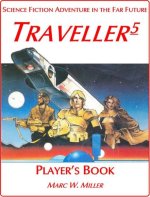That reminds me of the
cover for Citizen of the Galaxy, which is also a nicely iconic spaceships-and-barbarians image.
yeah similar motif
Cover has to be not so busy that the title doesn't stand out, must have areas of negative space allocated, colourful to catch the eye, in the flavour of the game, and must be consistent with the art style within the book (this last one of course is arguable)
the following is from
http://www.writersdigest.com/editor-blogs/there-are-no-rules/general/10-tips-for-effective-book-covers
The title should be big and easy to read. This is more important than ever. (Many people will first encounter your cover on a screen, not on a shelf.) This is such a well-worn cliche of cover design that I have a designer friend with a Facebook photo album called “Make the Title Bigger.”
Don’t forget to review a thumbnail image of the cover. Is the cover compelling at a small size? More people are buying books on a Kindle or mobile device, so you want the cover to read clearly no matter where it appears. You should also anticipate what the cover looks like in grayscale.
Do not use any of the following fonts (anywhere!): Comic Sans or Papyrus. These fonts are only acceptable if you are writing a humor book, or intentionally attempting to create a design that publishing professionals will laugh at.
No font explosions! (And avoid special styling.) Usually a cover should not use more than 2 fonts. Avoid the temptation to put words in caps, italics caps, outlined caps, etc. Do not “shape” the type either.
Do not use your own artwork, or your children’s artwork, on the cover. There are a few rare exceptions to this, but let’s assume you are NOT one of them. It’s almost always a terrible idea.
Do not use cheap clip art on your cover. I’m talking about the stuff that comes free with Microsoft Word or other cheap layout programs. Quality stock photography is OK. (iStockPhoto is one reliable source for quality images.)
Do not stick an image inside a box on the cover. I call this the “T-shirt” design. It looks extremely amateurish.
Avoid gradients. It’s especially game-over if you have a cover with a rainbow gradient.
Avoid garish color combinations. Sometimes such covers are meant to catch people’s attention. Usually, it just makes your book look freakish.
Finally: Don’t design your own cover. The only people who should consider designing their own covers are professional graphic designers—and even then, it’s not advisable.
the following is from
http://www.graphic-design.com/DTG/Design/book_covers/
read the original as well as it goes into much deeper detail and is a worthwhile read.
1. Know the material
2. Know the reader
3. Show the essence of the message
4. Layout to promote eyeflow
How do we do that?
NOTE THIS 1. Organize size of element in order of importance
NOTE THIS 2. Select color of element to stand out, and harmonize
NOTE THIS 3. Organize placement of elements to flow through the visual "story"
NOTE THIS 4. Make sure the reader's eye moves effortlessly from element to element
Slants. How about those slants? Slants must have a reason, and they should (usually) run in the same direction. If you break that rule, you should have an excellent reason, supporting the design.
Vertical type! If you introduce vertical type, it should run UP. The end of the passage must end in a position to continue the eye to the next element! Not off the page. (As in "down") If you break that rule, you should have an excellent reason, supporting the design.
Word weight? Weighting the words in typography is very important. There should be a clear and justified reason for sizing each element -- and that relates to hierarchy -- from most important to least important. Being the 3rd edition is not nearly as important as the author's name, and neither are as important as the qualifier or USP, which for this book is the 2nd most important element after the word Photoshop.
Color breaks! Why the two 'O's in Photoshop are red, we have no idea. But you can immediately see how that treatment completely destroys the word as a word.
There are only two criteria for breaking a word with letter colors:
NOTE THIS 1. Intent: there must be a clear reason, in support of the message
NOTE THIS 2. Readability: the word must be instantly readable as a single word.
Typography in Graphic Design
... type is your most powerful weapon - use it wisely
Contrast, posture and flow:
Elements in harmony, design with a purpose:
Blockbuster Illustration:
makes a great book cover? The one that makes someone purchase a book. While all of the entries had merit, there is one true winner -- the one that sells


